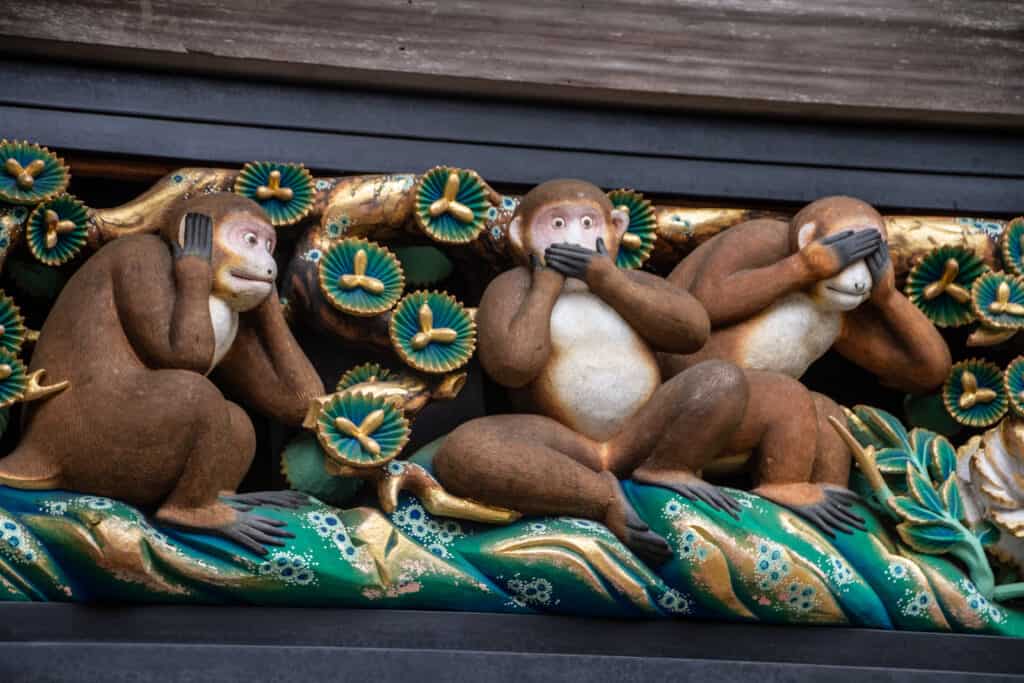Most people have their own ideas about the classic see no evil, hear no evil, speak no evil monkeys. They probably think of the three wise monkeys carved simply as decoration on a wooden plaque. Or, they may associate the phrase with the three iconic monkey emojis on social media apps in our modern world. However, the saying has a far more complex origin and symbolism. The idiom originates from Japan, and people worldwide know this expression. Though it is a proverb to preach morality, many people are curious about how this phrase came about.
Origins: See No Evil Hear, No Evil, Speak No Evil Monkeys

The age-old Japanese adage “see no evil, hear no evil, speak no evil” became popular during the 17th century in a Shinto pictorial format. People often use the phrase to describe those who turn a blind eye to bad behavior. It turns out there is a pretty interesting story behind it, though. The saying comes from an old Buddhist parable. The parable tells the story of three monkeys whose teacher ordered them not to see, hear, or speak evil. Each monkey tries to follow these directions, but they eventually fail. This story is meant to teach people awareness of their surroundings and not turning a blind eye to bad things.
The Story Behind the See No Evil, Hear No Evil, Speak No Evil Monkeys
The three monkeys in the story behind the famous proverb are Mizaru, Kikazaru, and Iwazaru. In Japanese culture, these monkeys are often called the Three Wise Monkeys or the Three Mystic Apes. The three monkeys, originating from this Buddhist story. They teach the importance of having good thoughts, speaking kindly, and doing good deeds.
The “see no evil” monkey Mizaru (ミザル) is often depicted with his hands over his eyes. He seems to be blocking the sight of evil.
The “hear no evil” monkey Kikazaru (キカザル) has his hands over his ears. This action helps block out the sound of evil.
The “speak no evil” monkey is Iwazaru (イワザル) covers his mouth with his hands. This monkey represents the idea of not saying bad or negative things.
These monkeys are often symbolic of positive thinking and doing good deeds. Many people believe that if you think, speak, and act like the three wise monkeys, you will have good luck. You might also see the three wise monkeys as a symbol of not paying attention to harmful things. People often use this symbol to encourage others to focus on the positive and not dwell on the negative. The three wise monkeys are a famous symbol in many cultures and are prevalent in art, literature, and films.
Why Monkeys Are Important in the Shinto Religion

Monkeys play an important role in the Shinto religion. In Japan, many shrines and temples have monkeys as their guardians. In addition, people who follow the Shinto religion believe that monkeys bring good luck and fortune. There are many stories and folktales about monkeys in Japanese culture. Additionally, monkeys are also vital in the Chinese zodiac. Those individuals born in the Year of the Monkey are supposedly intelligent, quick-witted, and resourceful. So why are monkeys so crucial in the Shinto religion and Japanese culture? Monkeys are symbols of good luck, happiness, and fertility. In many ways, they embody the qualities that people aspire to have. Many people also believe that monkeys possess magical powers and can protect them from evil spirits.
Real-Life Application
There are multiple real-life applications up for discussion about this well-known saying. However, in today’s world, we mostly use the phrase to stay out of trouble, especially when facing difficult decisions. This saying suggests that it is better to avoid potential problems by not paying attention to them. This approach can be helpful in some situations but can also lead to serious problems. For example, looking away if someone is threatened or harmed can worsen the situation. In contrast, there are times when it is better to stay out of something than to get involved. Suppose you witness a crime, for instance. In that case, it is usually best to go to the authorities rather than try to handle the situation yourself.
In general, the best way to deal with difficult situations is to use your best judgment. However, if you are not sure what to do, it is often better to err on the side of caution.
Pros and Cons of the See No Evil, Hear No Evil, Speak No Evil Monkeys as a Philosophy
When it comes to life philosophies, there are many different schools of thought. One such doctrine is the one we’re discussing. This philosophy dictates that people should avoid seeing bad things happening, hearing negative things, and speaking about unpleasant topics. While this may seem like a good, convenient way to live, this approach has pros and cons.
On the plus side, living according to this philosophy can help people remain optimistic. If people only focus on the good in the world, they will be less likely to be bogged down by negativity. Additionally, this thinking can help people avoid difficult conversations and situations. If people do not see or hear about the negative aspects of life, they believe they will not have to deal with them.
However, there are also some disadvantages to this mindset. One major downside is that it can cause people to be ignorant of important issues. If people only focus on the positive, they may not be aware of serious problems that are happening in the lives of others. Additionally, this way of thinking neglects to prepare people for adverse situations. If people do not think about bad things, they may not know how to deal with them if they do occur.
Overall, there are pros and cons to the see no evil, hear no evil, speak no evil monkeys philosophy. It is up to everyone to decide whether this is the right way of thinking for them.
More Than Just Emojis
Interestingly, the three monkey emojis we are all familiar with seem to embody a long history dating back to the ancient Japanese parable. There has been much debate on what these emoji monkeys symbolize. There has also been much discussion about whether there are three different monkeys or just one that represents three philosophies. However, in the end, the consensus is that they represent the three human virtues of prudence, justice, and temperance. So, yes, see no evil hear no evil, speak no evil monkeys in a nutshell.
The post See No Evil, Hear No Evil, Speak No Evil Monkeys: Meaning and Origins appeared first on AZ Animals.
from Animal News, Facts, Rankings, and More! - AZ Animals https://ift.tt/tygnoHR